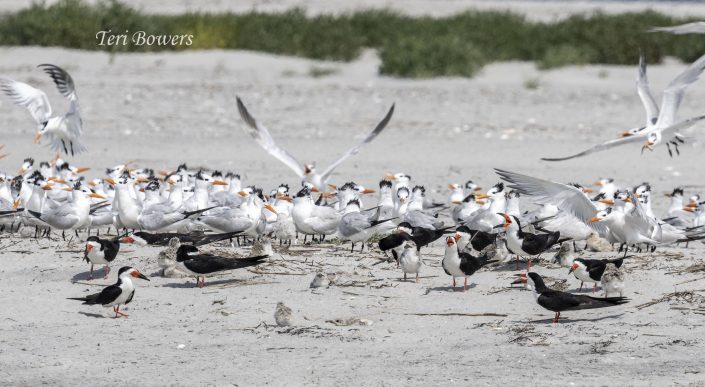A Return to Horseshoe Island
by Todd Pover, Senior Wildlife Biologist
This marked the second year that CWF worked in close partnership with New Jersey Fish and Wildlife and Edwin B. Forsythe National Wildlife Refuge (EBF) to monitor and manage birds on Horseshoe Island. The island, located just offshore on the southern edge of the Little Egg Inlet, has quickly become one of the most important sites for beach nesting birds in the state, as well as a critical resting and feeding site for migratory shorebirds.
Horseshoe Island hosted the state’s largest black skimmer (state endangered) colony this year with just over 1400 total adults or about 700 pairs. Although flooding and some avian predators impacted the overall nesting success at the island, at least 225 skimmer chicks “fledged” from the site. Horseshoe’s skimmer fledglings, along with those from nearby Holgate, a unit of EBF, and especially from Stone Harbor Point in Cape May County, made 2023 a moderately good productivity year for black skimmers in New Jersey.

Photo credit: Teri Bowers
Three different species of terns nested at Horseshoe Island again this year, including least terns (state endangered), common terns, and royal terns. The terns did not fare as well as the skimmers this year, primarily due to flooding. The royal tern colony is of special note as it is the northernmost colony on the U.S. Atlantic coast. That colony more than quadrupled in size this year up to just over 400 pairs. At some times during the season over 1000 royal terns were present on Horseshoe Island! Although limited by flooding, 65 royal tern chicks managed to successfully reach flight stage. Unfortunately, the least tern colony totally failed, and the common tern colony only managed to produce 32 fledglings.
A dozen pairs of American oystercatchers nested at Horseshoe Island this year, an increase from 2022, making it one of the top five sites in the state in terms of the number of breeding pairs. Oystercatchers experienced flooding issues this year, as well. In their case it was particularly ill-timed as a major “overwash event” occurred just before July 1, the date when oystercatchers typically will not renest again in a season. Three-quarters of the pairs hatched young only to see them washed away. With no pairs fledgling young in 2023 it reversed a pattern of Horseshoe Island being one of the most productive oystercatcher sites in the state in the previous year.
Also of note, piping plovers and red knot, both species are state and federally listed, continue to utilize the island, although no plovers have nested to date. And a notable number of roseate terns (also state and federally listed) were observed roosting on the island this year.
Nesting was first confirmed at Horseshoe Island by CWF just three years ago after the former emergent bar transitioned into an island that remained enough above high tide to support nesting. The island has continued to grow since then, storms especially altered its formation over the winter of 2022-23, more than doubling its size to an estimated 200-250 acres. Unfortunately, the changes also left it at a lower elevation, which contributed to the higher frequency of flooding this year. Even so, the island continues to be appealing to beach nesting birds, given there are no mammalian predators present at the site, a rare occurrence in New Jersey.
In recognition of the island’s importance and uniqueness for New Jersey’s wildlife, the state quickly stepped in, with support from federal officials and CWF, to develop a management plan for the island. The state’s Tidelands Resource Council approved a five-year plan to protect the island to benefit wildlife starting in 2022. The plan includes a provision to close the island to public use from March 1 to September 30.
As a result, people are not allowed on the island or the adjacent tidal lands, nor are boat or personal watercraft landings permitted, during the restricted period, which coincides with nesting and most of the highest migratory bird use. Human disturbance remains one of the primary limiting factors to reproductive success and long-term survival across these species, minimizing disturbance on the island is a critical element of the management plan. Public compliance with the closure improved in 2023, likely a result of boaters being more familiar with the rules during the second year of implementation, as well as renewed state law enforcement efforts.
A full report of the 2023 season at Horseshoe Island will be available in early 2024. More information about Horseshoe Island can be found here https://dep.nj.gov/njfw/conservation/horseshoe-island/
Discover more from Conserve Wildlife Foundation of NJ
Subscribe to get the latest posts sent to your email.